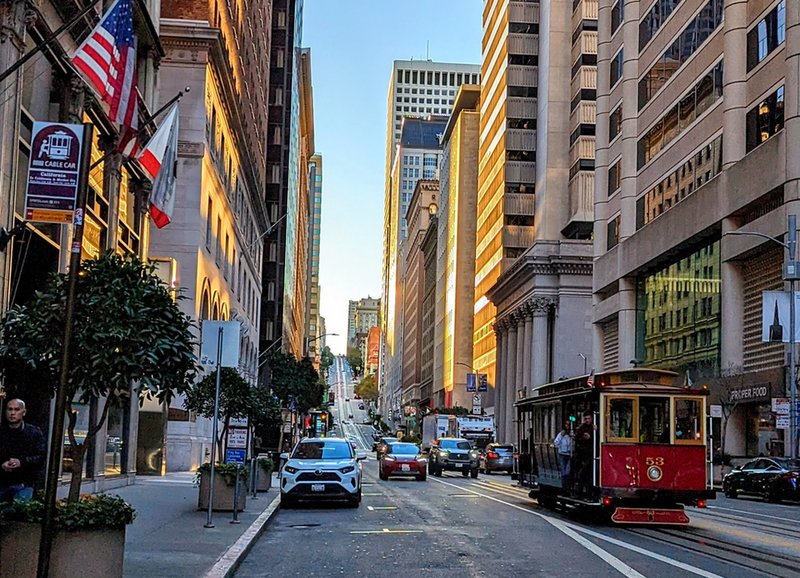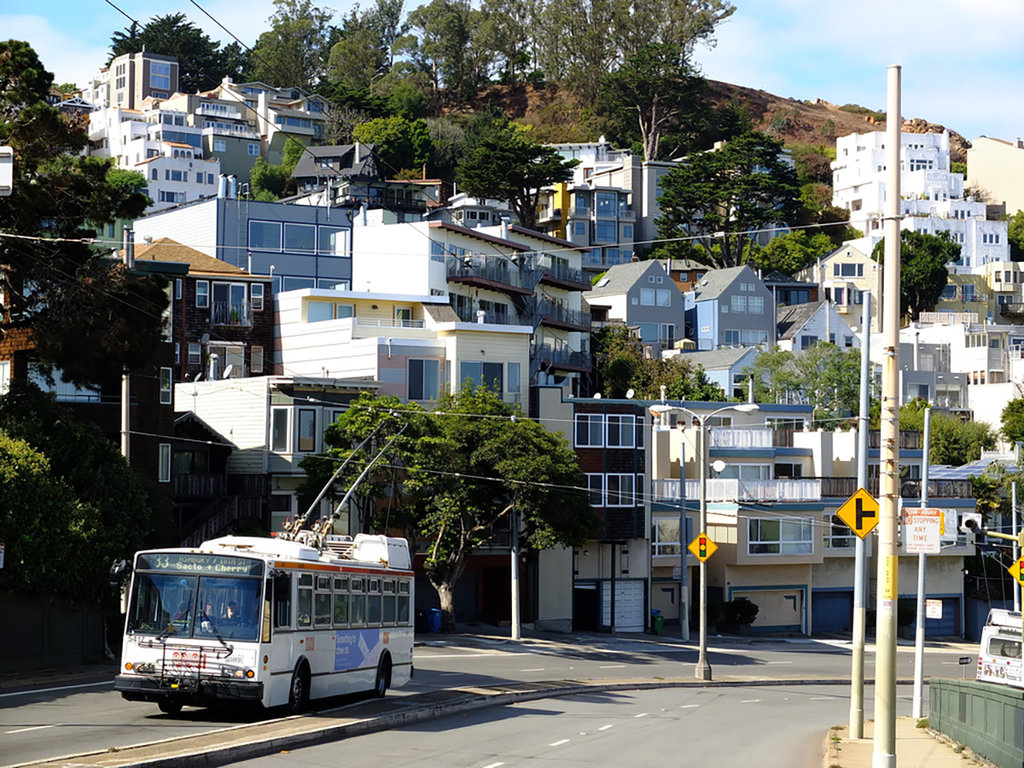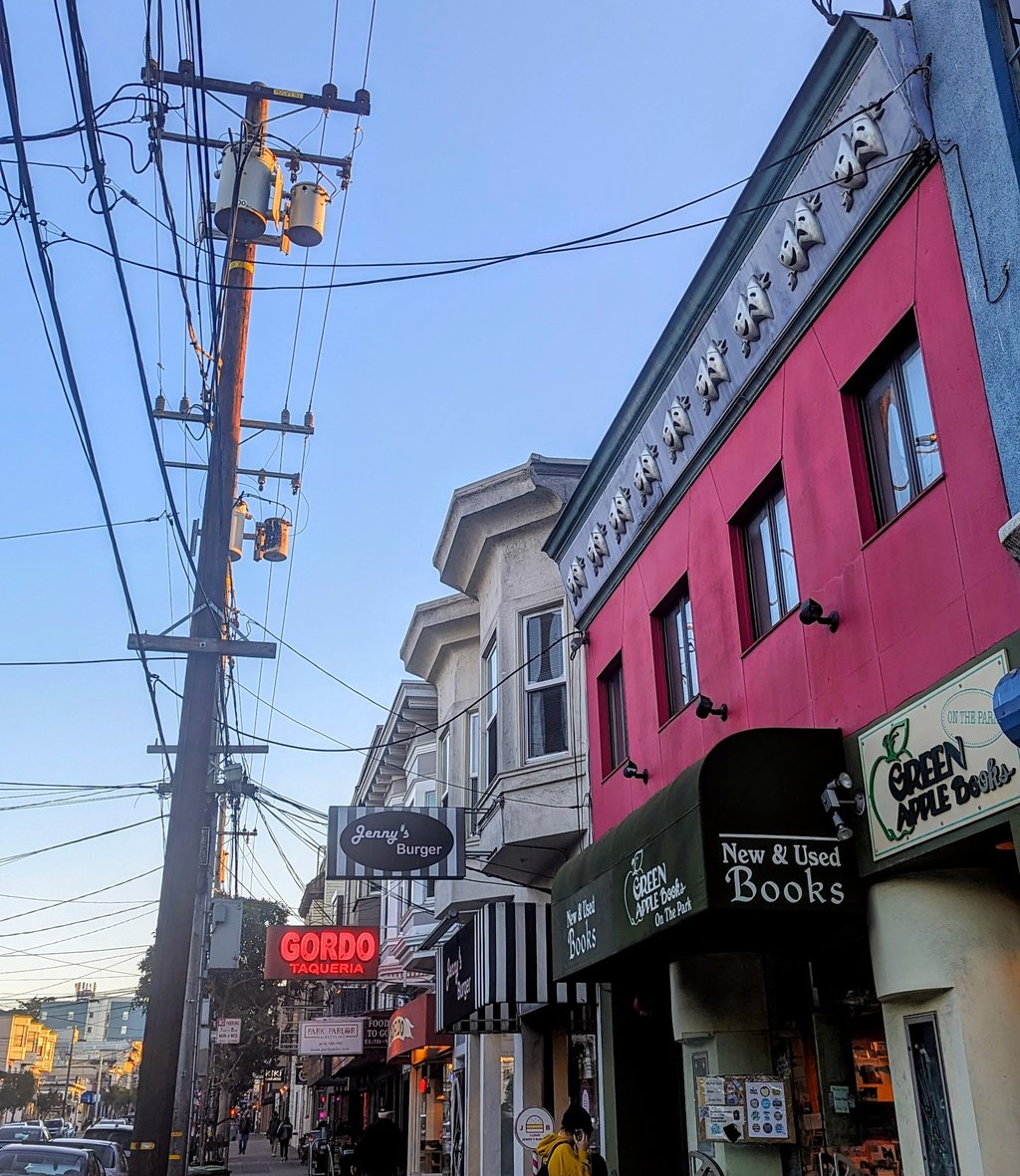Cover story
Lessons from San Francisco: 150 years of electric public transport
San Francisco is a pioneer of electric public transport systems, a legacy that has lasted for more than a century. As more countries around the world begin to ramp up commitments relating to electric transport as a way to decarbonise fast, what can San Francisco’s enduring success teach us? Annabel Cossins-Smith reports.

A retro cable car negotiates the steep hills of downtown San Francisco. Credit: Annabel Cossins-Smith
Walking through the streets of San Francisco’s inner city might feel, to those less used to skies saturated with cables and wires, like stepping into a different, more connected world. Pulled tight from each side of every road, filling the gaps between every house and tree, floats a vast network of electrical lines that provides power to, among many things, the city’s public transport system, which is now almost entirely electric. San Francisco’s fleets of buses, streetcars, trolley-buses, cable cars and trains are either already fully electric or in the process of becoming so. In the water that surrounds the city, the world’s first emissions-free ferries, powered by hydrogen fuel cells, are also beginning to be trialled.
The electrification of public transport systems has become central to climate policy around the world as efforts to meet national and international decarbonisation targets ramp up. Electric transport has become the biggest recipient of private and public spending within the energy transition, growing 36% in 2023 from the previous year and overtaking the renewable energy sector. All major international energy and climate change bodies, including the International Energy Agency (IEA), the World Resources Institute and the UN’s Intergovernmental Panel on Climate Change, agree that electrifying both personal and public transportation is key to effectively lowering global emissions and limiting the worst impacts of the climate crisis.
Despite this, there remains great disparity among countries and even cities within the same country on the proportion of electric transportation versus internal combustion engine transportation in its transit fleets. Today, two of the biggest barriers to an increase in the rollout of electric public transport across the world are large upfront costs and a lack of strong local or national policy. The former becomes especially true for the electrification of public transport fleets that have historically run solely on diesel or petrol-fuelled engines, such as buses.
In many cities across the world, the prevalence of electric public transport has been in steady decline over the past seven decades. In San Francisco, however, electrification has endured.
On policies regarding zero-emission vehicle mandates, California is a world leader, according to the IEA’s electric vehicles tracker – one explanation for San Francisco’s electrification success. However, on the financial side, a look into the history of the city’s public transport network and its enduring legacy today reveals a slightly more perspicacious story.
A legacy of electrification: the history of San Francisco’s public transport network
While the electrification of transportation might seem like a present-day phenomenon, pushed eagerly in recent years by governments, private companies and campaign groups alike in the name of climate action, some electric transport systems found in cities today are more than a century old. This is the case for San Francisco. The city has some of the oldest electric public transportation in the world, namely its cable cars and streetcars, both of which began operating in the 19th century, with some original lines still in use today. Even trials for battery electric buses, which remain relatively rare compared with other electric transport options due to the costs involved with switching fleets, began more than five decades ago in 1972.
On top of this, San Francisco’s transport operator, the San Francisco Municipal Transportation Agency (SFMTA), also known colloquially as Muni, is the oldest publicly owned transport operator in the US, established officially in 1912 after previous private, for-profit owners of the transit network faced a major workers strike over poor pay and working conditions.
However, what stands out most about San Francisco’s story is that every mode of transportation introduced since the late 1800s has stood the test of time and remains operational today. Take the trolley-bus, for example. In the 1950s, the trolleybus, often considered the ‘original’ electric bus, was at its peak of popularity in the US and operated in at least 30 major cities throughout the country. Today, that number has shrunk drastically to just five: San Francisco, Seattle, Philadelphia, Boston and Dayton. Among these, San Francisco has maintained the largest fleet. The city currently has 278 trolley-buses in use, representing around one-third of the total number of rubber-tyred transit fleet in the city, including diesel-powered buses.
Meanwhile, the ancient cable car, which has now been servicing the city for more than 150 years, has even managed to last through a devastating earthquake at the start of the 20th century and the rise of the more efficient, hugely popular streetcar which, had it not been for public protests, would have replaced the cable car altogether by mid-century.

A trolleybus manoeuvres its way through San Francisco’s suburbs. Credit: Robert Szymanski via Shutterstock
The same cannot be said for many other major cities in the US or for other countries around the world. Europe in particular has seen a massive decline in its electric tramways over the past few decades. A recent study found that over the 20th century, the number of towns with active electric tram systems has declined by more than 90% in France, England and Italy. In the UK, the significant decline in the use of tramways was largely due to the rise of the car, a mode of personal transport that quickly became popular with the influential middle class. Seen as getting in the way of cars on the road, tram networks began to lose popularity, with their ultimate demise in many cases being hastened by the Second World War. In some cities in Europe, such as London, Athens and others in the Czech Republic and Switzerland, trams were for a time replaced with trolley-buses, but in many instances, these too died out.
“A happy coincidence”: how San Francisco’s electric transportation has endured through time
So how did San Francisco manage to keep its fleets of cable cars, streetcars, trains and trolley-buses operational? “We kind of backdoored it in some ways,” says Paul Bignardi, principal transportation planner at the SFMTA. He explains that a “happy coincidence” of circumstances, involving San Francisco’s topography, cheap, clean electricity from the nearby Hetch Hetchy hydroelectric plant and a lack of local and federal government funding, allowed the city to maintain its electric roots when others could not.
Central San Francisco is full of very steep, long hills. “An electric motor can be geared to climb practically anything,” Bignardi says. Compared with old internal combustion engines, which possessed little power in their earlier years, electric motors were far superior in reaching the tops of the city’s hills.
“When I was a kid, we had buses that were operating on some of our steepest streets. They were old and we [Muni] didn’t have the money to replace them so we kept them in service. If they were loaded completely full with people, for the last block of climbing a very steep hill, people would have to get off the bus and walk to the top of the hill, and then get back on the bus. You didn’t have that problem with electric trolley buses or streetcars… they could literally climb anything.”
A “happy coincidence” of circumstances, involving San Francisco’s topography, cheap, clean electricity from the nearby Hetch Hetchy hydroelectric plant and a lack of local and federal government funding, allowed the city to maintain its electric roots when others could not.
At the most basic level, the physical landscape of the city has lent itself to the persistence of electric transport. Where other cities were able to abandon seemingly ageing systems in favour of fossil-fuelled buses out of sheer practicality, San Francisco sought to maintain its electric fleets.
“We also have our own power generation,” Bignardi continues. “Hydroelectric power from [the Hetch Hetchy plant in] the Sierra Nevada, about 200 miles from San Francisco. [Muni] made agreements with the local energy provider, which has generally been Pacific Gas and Electric, to get this power at a very reduced price, not quite for free, but it was very inexpensive – and it is also very clean. It makes sense”.
More than half of the public transport vehicles in San Francisco are now powered by the hydroelectricity produced at the Hetch Hetchy plant. It could be more, Bignardi explains, because Hetchy generates a lot more power than Muni requires, but much of the additional power capacity goes to other public services in the city, such as hospitals, via Northern California’s grid. That a vastly discounted, localised power source for the city’s transportation acted as a key incentive to maintain its electric systems also feeds into Bignardi’s final point: that a lack of funding and the general slowness of government during the 20th century essentially forced the city to reuse and recycle its existing transit fleets.

A mass of cables line the city’s streets and fill its skies, connecting its fleets of streetcars and trolley-buses to electric power. Credit: Annabel Cossins-Smith
“As I have sometimes joked, looking at our history, we are oftentimes the last to catch a wave of anything,” says Bignardi, explaining that during the 1950s, when internal combustion engine buses were being rolled out globally en masse, there was no financial aid coming from Washington or even from Sacramento, California’s regional capital. “Which is why we scrambled to keep our [electric transit] for as long as we could. The fact that we were poor at the time meant we had to hang on to our stuff because we didn’t have the money to buy diesel buses in the 1950s. We just didn’t have it.”
Muni went one step further. It didn’t just reuse and renovate its own ageing fleets; it also took advantage of other cities in the US that were throwing away their trolleybuses and streetcars as they were removing their electric transit systems. “We were buying them literally at pennies on the dollar,” says Bignardi.
Lessons from San Francisco
Similar stories of almost accidental, or coincidental, sustainability, achieved from a lack of financial capacity to keep up with the times, can also be observed in other parts of the world, particularly in eastern Europe.
Sofia, Bulgaria’s capital, is a good example. Its fleets of public transport are almost entirely in public possession, save for a handful of buses that mainly service the city’s suburban areas. It also has legacy tram and trolley-bus systems that have been maintained over the decades, from their first installations in 1901 and 1941, respectively, and are still operating and even expanding today.
Poland’s Tri-City, comprising the three cities of Gdańsk, Sopot and Gdynia, and Slovenia’s Ljubljana, as well as some bigger cities in Switzerland, similarly held onto old electrical transport systems and are now ranking very highly in decarbonisation tables. “They are doing well now in terms of decarbonising their network because they never got rid of those systems in the first place,” Celeste Hicks of the European NGO Clean Cities Campaign explains.
Oslo, Norway’s capital, is also doing exceptionally well with the electrification of its public transport system, although its story is, in some ways, the opposite to San Francisco’s. “The thing about Oslo is they have got absolutely loads of money,” Hicks says, referring to the city’s recent rapid expansion of its electric bus fleet, which is relatively straightforward to do in theory, she explains, but very expensive. While the city is also now benefitting from legacy electric tramways, unlike San Francisco and its eastern European counterparts, its current electric success can also be attributed to the funds it has readily available to pay the price of switching its diesel bus fleets – bought during the mid-century wave of internal combustion engine furore – over to electric power.
In the end, Bignardi says, San Francisco was, in many ways, “lucky”. “But maybe there is a lesson here: don’t throw out your old stuff. New isn’t always better.” What we can learn from San Francisco’s century-long electric success, as well as from those cities across the world with similar stories, is more far-reaching than looking simply at the development of a sustainable public transport network – although they have done this very well. In the City Survey 2023 Summary Report, the first resident satisfaction report carried out since 2019, satisfaction with Muni has increased, with the city’s transport services currently holding one of the highest rankings out of all of San Francisco’s public services.
Beyond this, the moral of Muni’s story, at its heart, echoes one of sustainability’s oldest adages: reduce, reuse, recycle. After being ‘left behind’ for decades, tied to its old, seemingly outdated electric systems, the city’s transit network has come full circle, standing now as one of the cleanest in the world. We could all learn a thing or two.